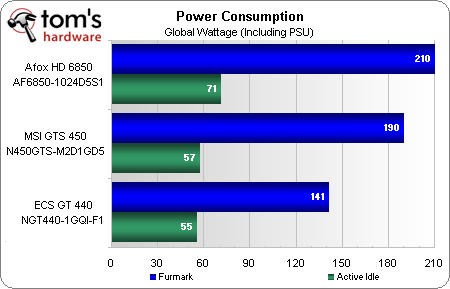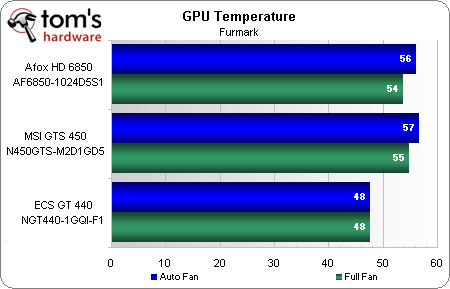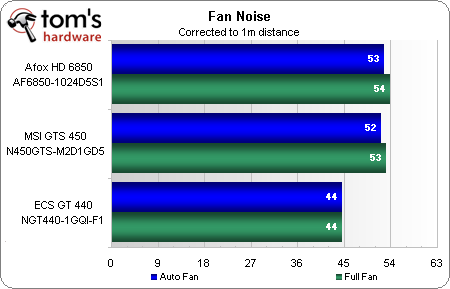Single-Slot Graphics: Whose Card Is Fastest?
Double-slot graphics cards seem to be the norm, much to the chagrin of enthusiasts trying to build systems with only a single slot of upgrade space. We hunted down three of the fastest cards able to slip into one slot and tested their gaming mettle.
Power, Heat, Noise, And Efficiency
Our power readings represent the entire test system, and our platform (excluding graphics) consumes roughly 48 W at idle and 96 W under full load. Additionally, the power supply draws about 11% off the top of every power reading, so we wanted to make it clear to readers that none of these cards can draw more than 200 W.
Remember that of this comparison’s samples, only the MSI GeForce GTS 450 has an auxiliary PCIe power cable connection. The Afox Radeon HD 6850 draws more energy, however. The indication to us is that the GeForce GTS 450 might not have needed the six-pin connector were it not for backward slot compatibility.
We think the presence of overkill power connectors on reference-designed graphics cards is an effort by GPU manufacturers to assure the highest level of compatibility. According to the PCI-SIG, some early boards only supported 75 W of power through first-gen PCIe slots.
Of course, most buyers won’t spend $200 on a graphics card simply to put it in a heavily-outdated system. Given the facts and power consumption stats above, we can only guess that a pair of Afox Radeon HD 6850 cards in CrossFire might not get adequate power from some more modern motherboards, and that guess corresponds to the proliferation of auxiliary power connectors on some of the same motherboards. Yet, buyers who have room for a pair of cards will likely purchase double-slot cards instead. Afox’s design is thus acceptable, if controversial.
FurMark pushes the thermal limits of a graphics card, and users need to keep their case temperature below 35° Celsius to test with it. That is, unless those users prefer the less-expensive GeForce GT 440.
Small fans must spin quickly to keep mid-sized graphics processors cool. The speeds that produce these noise levels are also detrimental to longevity, so the warranty periods on page one are particularly noteworthy. We'd like to see Afox augment its 12-month coverage with another couple of years.
In games, the biggest detriment to system efficiency is the overhead power for parts that support the GPU. With system overhead relatively consistent, the card that draws the least power also has the lowest gaming efficiency due to its reduced performance.
Get Tom's Hardware's best news and in-depth reviews, straight to your inbox.
Current page: Power, Heat, Noise, And Efficiency
Prev Page Performance Analysis Next Page Conclusion-
ta152h I'm not sure this needed so many pages to state the obvious (a 6850 board was faster than 440 and 450 boards, the concept is a good one. There are a lot of areas that sites do not cover that should be, and many of them are logistical like this one.Reply
For example, there are few, if any, reviews on noiseless CPUs (meaning, fanless) and too few if any reviews on GPUs without fans. Small form factors have thankfully been addressed a bit, but some of the smallest sizes are still not represented well in reviews.
Even if you are into killing evil Zargons with your pimped out main computer (which many are not anyway), there is still a cool factor of a computer that fits in your hand that can be used in other locations like a kitchen, or living room, or both since you can pick it up and move it easily.
Articles like this, that might not pertain to a main computer (or may), are interesting, since most of us have several computers, and know several people that ask our assistance in making decisions, and there are often criteria like this involved. -
dragonsqrrl I've read up to but not including the benchmark results, but is there honestly any question as to which card will perform best? The HD6850 is in a completely different performance segment. I'm just impressed they were able to get it down to a single slot form factor.Reply -
-Fran- You could have also included a standard reference board of the 6850 and GTS450 to see if there were any differences in power draw, heat, noise and why not, performance.Reply
Still, I also like the idea of reviewing different approaches of hardware pieces. We all have different needs, so different hardware (forms) need to be addressed as well 8)
Cheers! -
Crashman dragonsqrrlI've read up to but not including the benchmark results, but is there honestly any question as to which card will perform best? The HD6850 is in a completely different performance segment. I'm just impressed they were able to get it down to a single slot form factor.Afox wanted to present this to prove its solution viable. Lots of people thought it wouldn't work due to the missing 6-pin connector and tiny fan. A couple weeks after Afox released its card, PowerColor announced a single-slot version WITH the 6-pin connector so now you have three choices: Galaxy's 460, Afox's 6850, and PowerColor's 6850.Reply
The Tom's Hardware team put a lot of effort into getting as many companies onboard as possible for this. PowerColor should have been excluded since its product was actually too late to meet the test deadline, but that's a non-issue since the card didn't show up. And Galaxy, Galaxy Where Art Thou? You would think companies like that would be in touch with ALL the major sites, wouldn't you? -
mister g I was looking into these cards because I have a BTX case from Dell, Crashman just listed all the cards I was looking at except for the Afox. However I'm not likely to get any of these since the single slot comes with one big con, a price tag of at least $220.Reply -
dragonsqrrl CrashmanThe Tom's Hardware team put a lot of effort into getting as many companies onboard as possible for this. PowerColor should have been excluded since its product was actually too late to meet the test deadline, but that's a non-issue since the card didn't show up. And Galaxy, Galaxy Where Art Thou? You would think companies like that would be in touch with ALL the major sites, wouldn't you?I wasn't questioning the work ethic of Tom's Hardware's authors and reviewers, you guy's almost always deliver high-quality review material. But thanks for clarifying the situation.Reply
I really don't know what I would think, I'm completely unfamiliar with the process of acquiring test hardware from companies. Is this really unusual behavior from Galaxy and Power Color (ignoring or passing up a request to review one of their new products)? -
Crashman dragonsqrrlI wasn't questioning the work ethic of Tom's Hardware's authors and reviewers, you guy's almost always deliver high-quality review material. But thanks for clarifying the situation.I really don't know what I would think, I'm completely unfamiliar with the process of acquiring test hardware from companies. Is this really unusual behavior from Galaxy and Power Color (ignoring or passing up a request to review one of their new products)?I believe the OTHER companies simply didn't want to get "shown up" by the bigger card, where ECS and MSI sent a card they knew would lose the performance race in order to show off their lower power consumption and price.Reply
As for PowerColor, they said they sent one. Either they screwed up, or something happened to the card along the way. Either way, I wasn't going to worry about the cause of this conundrum since it was too late to deal with.
I really don't know what's up with Galaxy. Chances are they might have simply cut their marketing department.




